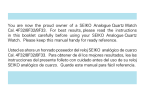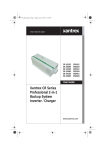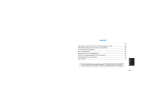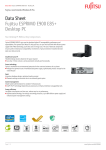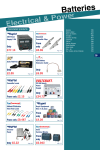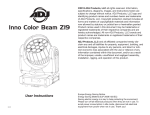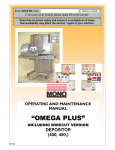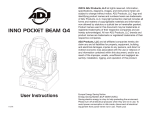Download Seiko 8F33 Specifications
Transcript
PARTS CATALOGUE / TECHNICAL GUIDE Cal. 4F32A, 8F32A Cal. 8F33A, 8F35A PARTS CATALOGUE / TECHNICAL GUIDE (p. 1 – 22) CATÁLOGO DE PARTES / GUÍA TÉCNICA (p. 23 – 44) [SPECIFICATIONS] Cal. No. Item 4F32A 8F32A 8F33A 8F35A Movement The illustrations refer to Cal. 8F32A. Movement size Outside diameter ø18.5 mm 17.7 mm x 18.5 mm ø26.4 mm 25.6 mm x 25.6 mm Casing diameter ø18.5 mm 17.1 mm x 18.5 mm ø26.4 mm 24.8 mm x 24.8 mm 3.9 mm 4.3 mm Height Including the ( battery portion ) (x 1.0) Time indication 3 hands (hour, minute and second hands) Driving system • Step motor (for hour, minute and second hands) • Ultrasonic motor (for calendar indication) Additional mechanism • Calendar (Leap year indication, month and date) Perpetual calendar up to February 28, 2100 • Train wheel setting device • Electronic circuit reset switch • Battery life indicator • Day calendar (Cal. 8F33A) • Instant calendar (day) setting device (Cal. 8F33A) Loss/gain Annual rate at normal temperature range: less than 20 seconds Regulation system Logical regulation (Pattern cutting system: 3 steps) Measuring gate by quartz tester Use 10-second gate. Battery Battery No. SEIKO CR1612, Sony CR1612, Matsushita CR1612 Voltage 3.0 V Battery life Approx. 5 years Jewels SEIKO CR2412, Matsushita CR2412 Approx. 10 years Approx. 8 years 4 jewels 1 PARTS CATALOGUE Cal. 4F32A, 8F32A, 8F33A, 8F35A Disassembling procedures Figs. : 1 → 43 Reassembling procedures Figs. : 43 ← 1 Lubricating: Types of oil Oil quantity Moebius A Normal quantity Moebius F Ex. : Cal. 8F32A 2 Battery (See the front page) 5 4216 115 (Cal. 4F32A) 4216 117 (Cal. 8F32A, 8F33A and 8F35A) Insulator for battery (A) 6 0016 704 Circuit block cover screw 7 4461 022 (Cal. 8F32A) 4461 024 (Cal. 8F33A) 4461 033 (Cal. 8F35A) Circuit block cover (For Cal. 4F32A, see page 5) 8 4403 218 (Cal. 4F32A) 4403 219 (Cal. 8F32A, 8F33A and 8F35A) Circuit block 9 4281 115 Date driving contact point spring 10 4281 118 24-hour contact point spring 11 4270 415 Battery connection (–) 12 4216 116 Insulator for battery (B) Note for Cal. 8F32A and 8F35A: When the hands and the dial are removed, the dial spacer will come off if the movement is turned over. Take care not to lose the dial spacer. * For disassembling and reassembling, use the movement holder for exclusive use with the respective calibres. ● For the dial side: • Movement holder 4F3-T for Cal. 4F32A • Movement holder 8F3-T for Cal. 8F32A, 8F33A and 8F35A ● For the case back side: • Movement holder 4F8F-C for all Cal. 4F and 8F Series ➡ 2 0016 704 • Circuit block cover screw • Train wheel bridge screw (4 pcs.) (2 pcs.) 0016 705 • Ultrasonic motor screw (2 pcs.) Please see the remarks on the following pages. PARTS CATALOGUE Ex. : Cal. 8F32A ➡ Cal. 4F32A, 8F32A, 8F33A, 8F35A 13 4002 115 Coil block 14 0016 704 Train wheel bridge screw 15 0125 254 Train wheel bridge 16 Fourth wheel and pinion 17 0231 116 Third wheel and pinion 18 0701 115 Fifth wheel and pinion 19 4146 116 Step rotor 20 0281 115 Setting wheel 21 0388 117 (Cal. 4F32A) 0388 116 (Cal. 8F32A, 8F33A and 8F35A) Yoke guard 22 0391 115 Train wheel setting lever 23 4239 115 Rotor stator 24 0261 115 (Cal. 4F32A, 8F32A and 8F33A) 0261 046 (Cal. 8F35A) Minute wheel and pinion 25 0383 115 (Cal. 4F32A) 0383 116 (Cal. 8F32A, 8F33A and 8F35A) Setting lever 26 0384 115 Yoke 27 Winding stem 28 0282 032 (Cal. 4F32A and 8F32A) 0282 117 (Cal. 8F33A) 0282 116 (Cal. 8F35A) Clutch wheel 29 4408 115 (Cal. 4F32A, 8F32A and 8F35A) Clutch wheel spacer 29 0962 119 (Cal. 8F33A) First intermediate wheel for calendar corrector 30 Center wheel and pinion 41 0016 705 Ultrasonic stator unit screw 42 4234 115 Ultrasonic stator unit 43 0100 136 (Cal. 4F32A) 0100 137 (Cal. 8F32A, 8F33A and 8F35A) Main plate Please see the remarks on the following pages. 3 PARTS CATALOGUE Cal. 4F32A, 8F32A, 8F33A, 8F35A Cal. 8F33A Cal. 4F32A, 8F32A & 8F35A Ex. : Cal. 8F32A 1 4408 116 (Cal. 8F32A and 8F35A) Dial spacer 32 0808 126 Date dial guard 33 Date dial 34 0810 115 Date jumper 35 Hour wheel 36 0817 118 Intermediate date driving wheel and pinion 4 0963 230 Snap for day star with dial disk 4 Day star with dial disk 31 0989 007 Day corrector wheel 32 0808 125 Date dial guard 33 Date dial 34 0810 115 Date jumper 35 Hour wheel 36 0817 118 Intermediate date driving wheel and pinion 37 0962 118 Second intermediate wheel for calendar corrector 38 4062 117 Ultrasonic rotor 39 1019 114 24-hour wheel 38 4062 117 Ultrasonic rotor 40 0802 115 Date driving wheel 39 1019 115 24-hour wheel 40 0802 115 Date driving wheel * Cal. 4F32A, 8F32A and 8F35A do not use the parts ➡ 3 3 , 4 , 31 and 37 . Please see the remarks on the following pages. PARTS CATALOGUE Cal. 4F32A, 8F32A, 8F33A, 8F35A Remarks: ● Back plate Some models do not use the back plate. ● Case ring The type of case ring is determined based on the design of cases. Check the case number and refer to “SEIKO Casing Parts Catalogue” to choose a corresponding case ring. 4 Day star with dial disk (Only for Cal. 8F33A) Cal. No. Part code Position of crown and calendar frame Color of figure Color of background 8F33A 0170 072 3 o’clock Black White The type of day star with dial disk is determined based on the design of cases. Check the part code printed on the disk. 7 Circuit block cover 16 Fourth wheel and pinion 30 Center wheel and pinion 35 Hour wheel • Discrimination of the hand installation height Cal. 4F and 8F Series watches have numerals printed on movement to indicate the hand installation height. When repairing, refer to the table below. Numeral for discrimination [ Cal. 4F32A ] Numeral for Circuit discrimination block cover Center wheel and pinion Fourth wheel and pinion Hour wheel 4461 021 0221 116 0241 449 0273 118 4461 020 0221 114 0241 448 0273 117 1 2 5 PARTS CATALOGUE Cal. 4F32A, 8F32A, 8F33A, 8F35A [ Cal. 8F32A and 8F33A ] Numeral for discrimination Center wheel and pinion Fourth wheel and pinion Hour wheel 0221 115 0241 446 0273 115 Center wheel and pinion Fourth wheel and pinion Hour wheel 0221 123 0241 446 0273 115 2 [ Cal. 8F35A ] Numeral for discrimination 2 27 Winding stem 0351 196 The type of winding stem is determined based on the design of cases. Check the case number and refer to “SEIKO Casing Parts Catalogue” to choose a corresponding winding stem. 33 Date dial Cal. No. Part code Position of crown and calendar frame Color of figure Color of background 4F32A 0878 321 3 o’clock Black White 8F32A 8F33A 0878 301 3 o’clock White Black 8F35A 0878 301 4 o’clock White Black The type of date dial is determined based on the design of cases. Check the case number and refer to “SEIKO Casing Parts Catalogue” to choose a corresponding date dial. 6 TECHNICAL GUIDE Cal. 4F32A, 8F32A, 8F33A, 8F35A • The explanation here is only for the particular points of Cal. 4F32A, 8F32A, 8F33A and 8F35A. • For the repairing, checking and measuring procedures, refer to the “TECHNICAL GUIDE, GENERAL INSTRUCTIONS”. I. STRUCTURE OF THE CIRCUIT BLOCK [ Cal. 4F32A ] “M” terminal (for month setting) “Y” terminal (for year setting) Input terminal (+) Coil block output terminal C-MOS-IC AC terminal “ø” terminal (for resetting the date dial) “D” terminal (for date setting) Crystal unit Input terminal (–) [ Cal. 8F32A, 8F33A and 8F35A ] “M” terminal (for month setting) “ø” terminal (for resetting the date dial) Input terminal (+) Coil block output terminal C-MOS-IC “Y” terminal (for year setting) “D” terminal (for date setting) Crystal unit Input terminal (–) AC terminal 7 TECHNICAL GUIDE II. Cal. 4F32A, 8F32A, 8F33A, 8F35A REMARKS ON DISASSEMBLING AND REASSEMBLING • For disassembling and reassembling, use the movement holder for exclusive use with the respective calibres. • When installing the hands, place the movement directly on a flat metal plate or a riveting plate. Battery ● Hour, minute and second hands • How to set the hands With the battery installed, place the movement directly on a flat metal plate or a riveting plate, taking care not to press down the hooking portions. To install the hands: Hooking portion Turn the crown clockwise until the date changes, and install the hands so that they point to the 12 o’clock position. To install the hands so that the date changes more accurately as the hands indicate 12 o’clock midnight: 1) Turn the crown clockwise until the date changes. 2) Give the crown four counterclockwise turns to make the date return to the previous date. 3) Turn the crown slowly clockwise until the date changes again. 4) Install the hands so that they point to the 12 o’clock position. • Setting position of the movement on the exclusive movement holder Check that the pins of the movement holder are securely set to the corresponding holes of the movement. [ Movement holder 4F3-T for the dial side of Cal. 4F32A movement ] Pin Hole to set the pin [ Movement holder 8F3-T for the dial side of Cal. 8F32A, 8F33A and 8F35A movements ] Pin 8 Hole to set the pin TECHNICAL GUIDE Cal. 4F32A, 8F32A, 8F33A, 8F35A [ Movement holder 4F8F-C for the case back side of all Cal. 4F and 8F Series movements ] Pin Hole to set the pin 2 Battery 5 Insulator for battery (A) • How to replace the battery • Be sure to complete the battery replacement work within three minutes. Otherwise, the calendar data stored in the built-in IC will be erased. • Before removing the old battery, be sure to keep a new battery at hand. • When installing the new battery, take utmost care not to short-circuit the battery connection (–) and the circuit block cover, as this will also erase the calendar data. • How to remove the battery The case ring has numerals printed on it to show the order of disengaging the hooking portions of the circuit block cover using the tips of the tweezers. [ Case ring for Cal. 4F32A ] [ Case ring for Cal. 8F32A, 8F33A and 8F35A ] 12 o’clock side Crown side 12 o’clock side Crown side 9 TECHNICAL GUIDE Cal. 4F32A, 8F32A, 8F33A, 8F35A [ Cal. 4F32A ] 1. Locate the position where numeral “1” is printed on the case ring, and insert the tips of the tweezers into the gap between the insulator for battery (A) and the circuit block cover, while taking care not to damage the coil. * Take care not to insert the tips of tweezers too deep into the gap as this may damage the coil. Tweezers Numeral “1” Circuit block cover 2. Insulator for battery (A) Insulator for battery (A) Numeral “2” Tweezers Circuit block cover Pry with the tweezers to disengage the hooking portion of the circuit block cover. Insulator for battery (A) Insulator for battery (A) Tweezers Circuit block cover Tweezers Hooking portion of the circuit block cover 3. 10 Circuit block cover Hooking portion of the circuit block cover Locate the position where numeral “2” is printed on the case ring, and use the tips of the tweezers in the same manner as in the steps “1” and “2” above and disengage the hooking portion of the circuit block cover to remove the battery. TECHNICAL GUIDE Cal. 4F32A, 8F32A, 8F33A, 8F35A [ Cal. 8F32A, 8F33A and 8F35A ] 1. Locate the position where numeral “1” is printed on the case ring, and insert the tips of the tweezers into the gap between the insulator for battery (A) and the circuit block cover . Then, pry with tweezers in the direction of the arrow in the illustration below to disengage the hooking portion of the circuit block cover. While doing so, take care not to damage the coil. * Take care not to insert the tips of tweezers too deep into the gap as this may damage the coil. Insulator for battery (A) Insulator for battery (A) Tweezers Tweezers Circuit block cover Hooking portion of the circuit block cover Circuit block cover 2. Locate the position where numeral “2” is printed on the case ring, and insert the tips of the tweezers into the gap between the insulator for battery (A) and the circuit block cover . Then, pry with tweezers in the direction of the arrow in the illustration below to remove the battery. Insulator for battery (A) Insulator for battery (A) Hooking portion of the circuit block cover Circuit block cover Tweezers Hooking portion of the circuit block cover Circuit block cover Tweezers 11 TECHNICAL GUIDE Cal. 4F32A, 8F32A, 8F33A, 8F35A • How to install the battery (For Cal.4F32A, 8F32A, 8F33A and 8F35A) [A] When the dial and hands are installed, set the time to 6:00 AM or PM. [B] When the dial and hands are not installed, direct the notched portion of the 24-hour hand toward the 9 o’clock side. Notched portion of 24-hour hand 9 o’clock side Note: When installing the battery, take care lest the battery connection (–) should touch the four hooking portions of the circuit block cover, the grounding portion and the portion for battery check. 1. Before installing the battery, straighten the three hooking portions of the insulator for battery (A). Note: Set the insulator for battery (A) securely in position, as it easily gets out of position. Insulator for battery (A) Grounding portion Hooking portion Hooking portion Portion for battery check 2. First, set a part of the battery into the portion for battery check in the direction indicated by the arrow 1 , and then, press it down to install it completely. 1 Grounding portion Portion for battery check 12 TECHNICAL GUIDE Cal. 4F32A, 8F32A, 8F33A, 8F35A • Necessary procedure after battery change 1. After the battery is replaced with a new one, be sure to contact the “AC” terminal of the circuit block and the (+) surface of the battery with conductive tweezers for more than three seconds, with the crown at the normal position. 2. Pull out the crown all the way to the second click, and then, push it back in to the normal position. Repeat this procedure twice. • If the date dial returns to the current date, and the second hand starts moving at one-second intervals, the calendar data is securely retained. • If the date dial will not turn, and the second hand starts moving at 5-second intervals, the calendar data has been erased. ➪ ➪ Input the calendar data following the procedure in “Inputting the calendar data”. The battery replacement work has been completed successfully. Next, set the time. • Inputting the calendar data ■ Basic routine of inputting each type of calendar data 1) Contact the (+) surface of the battery and the terminal of the circuit block (“ø”, “Y”, “M” or “D”) with conductive tweezers once to activate the mode of inputting the desired type of data to the watch. 2) Contact the (+) surface of the battery and the terminal of the circuit block with tweezers repeatedly to turn the date dial until the desired numeral appears in the calendar frame. Each contact with the tweezers advances the date dial by one. It advances one by one and will not be advanced quickly. • Input each type of calendar data in the following order: ø Y Set the date dial to the current year. Set the date dial to “1”. Month setting D ▲ Year setting ▲ ▲ Resetting the date dial position M Set the date dial to the current month. Date setting Set the date dial to the current date. * Be sure to reset the date dial position first. • Positions of each terminal of the circuit block [ Cal. 4F32A ] [ Cal. 8F32A, 8F33A and 8F35A ] “AC” Tweezers “Y “ (Year) “Y “ (Year) “D” (Date) Tweezers “M” (Month) “ø” “M” (Month) “ø” “D” (Date) “AC” 13 TECHNICAL GUIDE Cal. 4F32A, 8F32A, 8F33A, 8F35A ■ Procedure of inputting the calendar data 1. Pull out the crown all the way to the second click. 2. Reset the position of the date dial. (ø) First, contact the “ø” terminal and the (+) surface of the battery with conductive tweezers to activate the date dial resetting mode, and then, contact the two portions repeatedly with tweezers until “1” appears in the calendar frame. 3. Set the year. (Y) Contact the “Y” terminal and the (+) surface of the battery with conductive tweezers to activate the year setting mode. “1” appears in the calendar frame. Then, contact the two portions repeatedly with tweezers until the current year appears in the calendar frame. Notes: * The date dial turns back when the numeral returns from “4” to “1” in the calendar frame. * If any data has already been input before the year setting mode is activated, a numeral other than “1” may appear in the calendar frame. 2 Two years since the last leap year 3 4 ▲ One year since the last leap year ▲ 1 ▲ Numeral in the calendar frame: Three years since the last leap year Leap year ▲ Numeral in the calendar frame 1 2 3 4 One year since the last leap year Two years since the last leap year Three years since the last leap year Leap year 1998 2002 2006 2010 • • 2086 2090 2094 2098 1999 2003 2007 2011 • • 2087 2091 2095 2099 Year 4. 1997 2001 2005 2009 • • 2085 2089 2093 2097 2000 2004 2008 2012 • • 2088 2092 2096 Set the month. (M) Contact the “M” terminal and the (+) surface of the battery with conductive tweezers to activate the month setting mode. “1” appears in the calendar frame. Then, contact the two portions repeatedly with tweezers until the current month appears in the calendar frame. Notes: * The date dial turns back when the numeral returns from “12” to “1” in the calendar frame. * If any data has already been input before the month setting mode is activated, a numeral other than “1” may appear in the calendar frame. 10 11 ▲ 9 ▲ 8 ▲ 7 ▲ 6 ▲ 5 ▲ 4 ▲ 3 ▲ 14 2 ▲ ▲ ▲ 1 ▲ Numeral in the calendar frame: 12 TECHNICAL GUIDE 5. Cal. 4F32A, 8F32A, 8F33A, 8F35A Set the date. (D) Contact the “D” terminal and the (+) surface of the battery with conductive tweezers to activate the date setting mode. “1” appears in the calendar frame. Then, contact the two portions repeatedly with tweezers until the current date appears in the calendar frame. Notes: * The date dial only advances and will not turn back in the date setting mode. * If any data has already been input before the date setting mode is activated, a numeral other than “1” may appear in the calendar frame. 6. Check if the day dial is reset to “1”. Contact the “ø” terminal and the (+) surface of the battery with conductive tweezers once to check that “1” appears in the calendar frame. If not, repeat the procedure again starting from step “2” above. 7. Push back the crown in to the normal position, and check if the number of years since the last leap years, month and date are correctly set. (See “How to check the calendar” below) ● How to check the calendar Pull out the crown to the first click, and push it back in to the normal position within a second. * Take care not to pull out the crown all the way to the second click. The calendar cannot be checked. The calendar will be shown in the frame in the following order. ▲ ▲ (1) Year (2) Month (3) Date (1) The second hand moves at 5-second intervals and stops. The number of seconds it has advanced indicates the number of years that have passed since the last leap year. Five seconds correspond to one year. * Before pulling out the crown to the first click, check and remember where the second hand is so that you can read how many seconds it has advanced. * If the second hand has advanced 20 seconds (four times of five seconds), the current year is the leap year. Quick movement of the second hand 5 seconds 10 seconds 15 seconds 20 seconds Number of years since the last leap years 1 year 2 years 3 years 4 years (leap year) (2) After the second hand indicates the number of years since the last leap year, the numeral in the calendar frame changes to indicate the current month for five seconds. (3) After the current month is shown, the current date is indicated in the calendar frame. * When the month and date are represented by the same numeral as in the case of “January 1st”, “February 2nd” and so on, the numeral in the calendar frame quickly advances and moves back by one to indicate that the month and date numerals are identical. (4) After the current date is shown, the second hand quickly moves to catch up with the current second and starts moving at normal one-second intervals thereafter. (5) If the calendar is correctly set as you intended, set the desired time. 15 TECHNICAL GUIDE Cal. 4F32A, 8F32A, 8F33A, 8F35A * If the year, month or date is not correctly set, repeat the procedure of inputting the calendar data starting from step “1”. 7 Circuit block cover When setting the circuit block cover, take care not to press down the terminal for battery check and the grounding terminal. [ Cal. 4F32A ] Terminal for battery check 8 [ Cal. 8F32A, 8F33A and 8F35A ] Terminal for battery check Grounding terminal Circuit block Before replacing the circuit block, make sure that the crown is pulled out to the first click. Also, check that the tip of the reset lever is positioned at the center of the eyehole as shown in the illustration below, and then, reassemble the circuit block. Note: When setting the circuit block, take care not to press down on the reset lever. Reset lever terminal 9 Date driving contact point spring 10 24-hour contact point spring • Setting position Date driving contact point spring 24-hour contact point spring 4281 115 4281 118 Note: The date driving contact spring and the 24-hour contact point spring contact with the circuit block to drive and control the ultrasonic motor. Handle them with care so as not to bend or straighten these parts, as this will cause defective contact with the circuit block, resulting in a malfunction of the ultrasonic motor and defective calendar indication. 16 TECHNICAL GUIDE 15 Cal. 4F32A, 8F32A, 8F33A, 8F35A Train wheel bridge • Setting position of wheels Step rotor Fifth wheel and pinion Setting wheel Minute wheel and pinion Fourth wheel and pinion Third wheel and pinion 22 Train wheel setting lever 25 Setting lever 26 Yoke Train wheel setting lever • Setting position Setting lever Yoke Note: Take care not to deform the spring portion of the yoke. While the circuit block cover is removed, do not pull out or push in the crown. 28 Clutch wheel Clutch wheel Install the clutch wheel in such a manner that the gear having smaller teeth faces toward the center of the center wheel and pinion. Clutch wheel spacer 31 Day corrector wheel (For Cal. 8F33A) • How to remove To remove the day corrector wheel from the second intermediate wheel for calendar corrector, insert a tip of tweezers into the hole of day corrector wheel as shown in the illustration, and move it toward the center tube of the movement (in the direction of the arrow in the illustration). Tip of tweezers Day corrector wheel Day corrector wheel 17 TECHNICAL GUIDE 32 Cal. 4F32A, 8F32A, 8F33A, 8F35A Date dial guard Unlike conventional movements, the date dial guard is not fixed with screws. It is set to the main plate with the three protrusions, which are caught under the main plate by turning the guard. Then, it is fixed by the two guide pins. B portion • How to remove 1. Lightly lift the A portion of the date dial guard with tweezers to clear it from the guide pin, and then, move it in the clockwise direction until it gets on the guide pin. 2. Release the B portion of the date dial guard in the same manner as you release the A portion, and then, move it in the clockwise direction until it gets on the guide pin. 3. Check that all the three protrusions of the date dial guard have come off from the main plate, and then, remove the date dial guard. Protrusion A portion Date dial guard Tweezers Note: Take care not to deform the date dial guard, as it is softly built. Guide pin • How to install 1. Put the date dial guard on the main plate so that the A and B portions are over the guide pins, as shown in the illustrations at right. 2. Move protrusion D of the date dial guard in the counterclockwise direction so that it is caught under the main plate. 3. B portion Protrusion C Slightly move protrusions C and E in the counterclockwise direction alternately to set them under the main plate. While doing so, set the A and B portions of the date dial guard to the guide pins. Note: Take care not to press down the ultrasonic rotor pinion while installing the date dial guard. Ultrasonic rotor pinion Protrusion E • How to remove the date dial guard in replacing the date dial (with the parts on the movement side installed) 18 Protrusion D Be sure to use the movement holder 4F8F-C for exclusive use for replacing the date dial. 24-hour wheel Note: Never remove the date driving wheel and the 24-hour wheel. Otherwise, the date driving contact point spring and the 24-hour contact point spring will come off. Date driving wheel A portion TECHNICAL GUIDE Cal. 4F32A, 8F32A, 8F33A, 8F35A 36 Intermediate date driving wheel and pinion 38 Ultrasonic rotor 39 24-hour wheel 40 Date driving wheel 24-hour wheel Ultrasonic rotor Intermediate date driving wheel and pinion • Setting position (For Cal. 4F32A, 8F32A and 8F35A) Date driving wheel Refer to the illustration at right. Note: Take care not to damage or deform the pinions of the ultrasonic rotor and date driving wheel in reassembling and disassembling, as they are made of plastic. 36 Intermediate date driving wheel and pinion 37 Second intermediate wheel for calendar corrector 38 Ultrasonic rotor 39 24-hour wheel 40 Date driving wheel 24-hour wheel Second intermediate wheel for calendar corrector Ultrasonic rotor Intermediate date driving wheel and pinion • Setting position (For Cal. 8F33A) Date driving wheel Refer to the illustration at right. Note: Take care not to damage or deform the pinions of the ultrasonic rotor and date driving wheel in reassembling and disassembling, as they are made of plastic. 38 Ultrasonic rotor 42 Ultrasonic stator unit Note: When holding the ultrasonic rotor and ultrasonic stator unit with tweezers, be sure to catch the portions illustrated below. Otherwise, their functions will be adversely affected. Ultrasonic rotor Ultrasonic stator unit Tweezers Tweezers Tweezers 19 TECHNICAL GUIDE III. Cal. 4F32A, 8F32A, 8F33A, 8F35A VALUE CHECKING ● Coil block resistance 3.6 KΩ ~ 4.0 KΩ Measuring the coil block resistance 1. Measure the resistance with the coil block installed on the main plate. 2. Apply the red and black probes of the tester to the patterns of the coil lead terminal. While doing so, take care not to touch the end portion of the coil lead terminal, as this will break the coil wire. ● Current consumption For the whole movement : Less than 1.3 µA (with voltage of 3.0 V supplied from a battery) For the circuit block alone : Less than 0.9 µA (with voltage of 3.0 V supplied from a battery) Measuring the current consumption for the whole movement 1. Check that the crown is in the normal (pushed in) position. Black probe Red probe 2. Apply the red and black probes of the tester to the circuit block cover and the pattern of the (–) terminal of the circuit block, respectively. 3. After connecting the tester, contact the “AC” terminal of the circuit block and the circuit block cover with conductive tweezers. Then, after approximately 20 seconds, start measurement, checking that a stable measurement is obtained. Measuring the current consumption for the circuit block alone 1. Connect the tester to the input terminals (+) and (–), and contact the “AC” and (+) terminals with conductive tweezers. Then, after approximately 10 seconds, start the measurement, checking that a stable measurement is obtained. * While measuring current consumption, be sure to protect the circuit block from light with black cloth or the like, as the light may increase the current consumption, resulting in an inaccurate measurement. Note: When the current consumption for the whole movement exceeds the standard value while the current consumption for the circuit block alone is within the standard value range, a driving pulse may be generated to compensate for the heavy load applied on the gear train, etc. In that case, overhaul and clean the movement parts, and then, measure the current consumption for the whole movement again. 20 TECHNICAL GUIDE Cal. 4F32A, 8F32A, 8F33A, 8F35A ● Time accuracy • The time accuracy measurement should be made in an environment with the temperature at the range of 23° C ± 2° C and humidity between 50% and 60%. Normal loss/gain at a normal temperature (23° C) : +0.020 ~ +0.140 sec./day [A] Check the loss/gain of the watch with the case back closed following the procedure below, and determine the method of adjustment and repair. Measuring procedure Measured loss/gain (–/+) 1 Set the gate of the quartz tester to “10”. 2 Pull the crown to the second click to stop the second hand. 3 Place the watch on the microphone with its 3 o’clock side up, and read the loss/gain. Normal : +0.020 ~ +0.140 Defective : –0.012 ~ +0.019 +0.141 ~ +0.204 Defective : –0.013 or smaller +0.205 or greater Method of adjustment/repair ➡ Time accuracy adjustment is not necessary. ➡ Adjust the time accuracy. ➡ Replace the circuit block with a new one. ➡ Check the time accuracy. ➡ (Then, adjust the time accuracy.) Notes: * The loss/gain indicated by the tester varies slightly from measurement to measurement. Therefore, make several measurements to get an average loss/gain. * When measuring time accuracy, leave the watch untouched for 30 minutes after it is placed on the microphone. Then, start the measurement. [B] Time accuracy adjustment by pattern cutting Cut and remove the overhanging pattern with tweezers to adjust the time accuracy. Notes: * After cutting the pattern, check that it is completely detached. * Take care not to let the cut pattern get inside the movement. Pattern cutting combination and adjustment range By cutting one or both of the patterns P1 and P2, the loss/gain of the watch can be adjusted by an amount between –0.064 and +0.032 sec./day. Pattern P2 P1 Amount of loss/gain from base accuracy –0.064 –0.032 +0.032 : Cut : Connected P1 P2 Note: Once the patterns are cut off, reconnecting them by soldering may not adjust the loss/gain by the amount specified in the table above and may also change the temperature characteristics of the watch. Adjust the loss/gain, therefore, only by cutting the patterns. 21 TECHNICAL GUIDE Cal. 4F32A, 8F32A, 8F33A, 8F35A [C] Example of the time accuracy adjustment Step 1 Measure the loss/gain of the watch with the case back closed. Obtained loss/gain: +0.180 sec./day Step 2 Find the amount of deviation from the allowable range of loss/gain between +0.020 and +0.140 sec./day. Deviation from the allowable accuracy: +0.180 – (+0.140) = +0.040 sec./day Step 3 Remove the circuit block and adjust the accuracy. Find a value of loss/gain from the table above that can offset the deviation obtained in Step 2 and bring the loss/gain within the allowable range. In this example, –0.064 sec./day is adequate, so cut the pattern P2. Step 4 Install the circuit block you have adjusted to the movement, and measure the loss/gain of the watch with the case back closed to check if the obtained loss/gain is within the allowable range between +0.020 and +0.140 sec./day. [D] Remarks on measuring the time accuracy • Measure the loss/gain at a temperature range of 23° C ± 2° C with humidity between 50% and 60%. • If you hold the watch in your hand for a long time before measuring the accuracy, the temperature of the watch itself will rise and a stable measurement may not be obtained even in the environment specified above. In that case, leave the watch untouched in the above environment for a sufficient period of time, and then, start the measurement. • Use a quartz tester QT-2100 that can measure a loss/gain up to 0.001 sec./day. ■ Tips on repairing The following are the troubleshooting guide for the problems particular to Cal. 4F32A, 8F32A, 8F33A and 8F35A. Problem The date dial will not move or the date does not change properly. 22 Possible cause Remedies 1) Wrong calendar data was input. 1) Newly input the calendar data. 2) Defects in the ultrasonic motor 2) Check the wheels around the ultrasonic motor. 3) Defects in the circuit block and contact point springs 3) Replace the circuit block, 24-hour contact point spring and date driving contact point spring all in a set.























